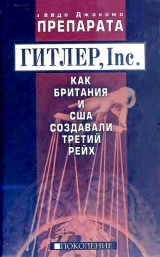
Текст книги "Гитлер, inc. Как Британия и США создавали Третий Рейх."
Автор книги: Гвидо Препарата
Жанры:
Публицистика
,сообщить о нарушении
Текущая страница: 28 (всего у книги 30 страниц)
dal 1890 al 1914 (Torino: Piccola biblioteca Einuadi, 1979), p. 157.
44. Balachandran,yo/*ft Bullion's Empire, p. 92.
45. William Adams Brown Jr., The International Gold Standard Reinterpreted,
1914-1934 (New York: National Bureau of Economic Research, Inc., 1940), p. 295.
46. Hardy, Enough Gold?, p. 93.
47. Adams Brown, Gold Standard, p. 294.
48. Ibid., p. 290.
49. Ibid., p. 301.
50. Eichengreen, Golden Fetters, p. 164.
51. Boyle, Norman, pp. 147-8.
52. Melchior Palyi, The Twilight of Gold 1914-1936. Myths and Realities
(Chicago: Henry Regnery Company, 1972), p. 144.
53. Hjalmar Schacht, My First Seventy-six Years. The Autobiography of Hjalmar
Schacht (London: Allen Wingate, 1955), p. 131.
54. Ibid.
55. Anton Chaitkin, Treason in America, from Aaron Bun to Averell Hani man.
(New York: New Benjamin Franklin House, 1985), p. 545.
56. Ibid., p. 546; emphasis added.
57. Schacht, Autobiography, p. 188.
58. Clay, Lord Norman, p. 197.
59. Bank of England, G1/44-419, p. 123, quote from an article of Carl von
Ossietzky on the Weltbuhne, November 27, 1928.
60. Boyle, Norman, p. 169.
61. Ibid., p. 171.
62. Schacht, Autobiography, p. 194.
63. Boyle, Norman, p. 171.
64. Charles L. Mowat, Britain Between the Wars, 1918-1940 (Chicago:
University of Chicago Press, 1955), p. 373.
65. Boyle, Norman, p. 159.
66. Geminello Alvi, DelVestremo occidente. II secolo americano in Europa. Storie
economiche (Firenze: Marco Nardi Editore, 1993), p. 195.
67. Ibid., p. 197.
68. Paul R. Leach, That Man Dawes (Chicago: Reilly 8c Lee Co., 1930),
pp. 206-7.
69. Ibid., p. 194.
70. Quigley, Tragedy, p. 308.
71. Alvi Occidente, pp. 197-8.
72. Ibid., p. 199.
73. Maurice Callot, Le mark allemand depuis 1924 (Paris: Librairie Arthur
Rousseau, 1934), p. 20.
74. Boyle, Norman, p. 197.
75. Alvi, Occidente, p. 208.
76. Demetre Delivanis, La politique des banques allemandes, en matiere
de credit a7 court terme (Paris: Librairie du Recueil Sirey, 1934), p. 53.
77. Alvi, Occidente, p. 198.
78. Louis T. McFadden, Collected Speeches of Congressman Louis T. McFadden,
as Compiled from the Congressional Record (Hawthorne, CA: Omni Publications, 1970), p. 204.
79. Quigley, Tragedy, p. 308.
80. Theo Balderston, The Origins and Causes of the German Economic Crisis,
November 1923 to May 1932 (Berlin: Haude & Spener, 1993), p. 134.
81. Garl T. Schmidt, German Business Cycles, 1924-1933 (New York:
National Bureau of Economic Research, 1934), p. 71.
82. Balderston, Origins and Causes, p. 140.
83. Garet Garrett, The Rescue of Germany & As Noble Lenders (New York: The
Chemical Foundation, 1931), p. 3.
84. McFadden, Collected Speeches, p. 57.
85. Derek Aldcroft, From Versailles to Wall Street, 1919-1929 (New York:
Penguin Books, 1978), p. 90, and Quigley, Tragedy, p. 309.
86. Paul Oesterfeld, La leggende delVoro (Roma: Casa Editrice Mediterranea,
1943), pp. 171, 182-3.
87. Garrett, Rescue of Germany, pp. 36-40.
88. Arthur Rosenberg, Storia delta repubblica tedesca (Deutsche Republik)
(Roma: Edizioni Leonardo, 1945 [1934]), p. 193.
89. Kastner, Fabian, p. 33.
90. Rosenberg, Storia delta repubblica tedesca, pp. 198, 199, 210.
91. Delivanis, Politique des banques, p. 52.
92. Joseph Borkin, The Crime and Punishment of I. G. Farben (New York: The
Free Press, 1978), p. 7.
93. Richard Sasuly, /. G. Farben (New York: Boni & Gear, 1947), p. 40.
94. Borkin, Crime and Punishment, p. 21.
95. Ibid., p. 1.
96. Ibid., p. 28.
97. Anthony C. Sutton, Wall Street and the Rise of Hitler (Sudbury, Suffolk:
Bloomfield Books, 1976), p. 33.
98. William Manchester, The Arms of Krupp, 1857-1968 (Boston: Little,
Brown and Company, 1968), pp. 348-50.
99. Borkin, Crime and Punishment, p. 45.
100. Ibid., p. 54.
101. Sasuly, /. G. Farben, p. 148.
102. Sutton, Rise of Hitler, p. 35.
103. Sasuly, /. G. Farben, p. 149.
104. Sutton, Rise of Hitler, pp. 35, 36.
105. Ibid., p. 22; emphasis added.
106. Andrej Gromyko, Lespansione internazionale del capitate, storia e attualitd
(Roma: Editori Riuniti, 1985 [1982]), p. 139.
107. Sutton, Rise of Hitler, pp. 51-66.
108. Palyi, Twilight of Gold, p. 155.
109. Quigley, Tragedy, p. 308.
110. Garrett, Rescue of Germany, p. 29.
111. Stephen V. O. Clarke, Central Bank Cooperation, 1924-1931 (New York:
Federal Reserve Bank of New York, 1967), p. 85.
112. Adams Brown, England, p. 206.
113. Ibid., pp. 213-14, 220-1, and Adams Brown, Gold Standard, 1940,
p. 368.
114. В результате особых положений «Золотого акта» 1925 года, касающихся конвертируемости, доля золота в мировом денежном обращении равнялась к 1928 году до 8 процентов, в то время как
в 1913 году эта доля составляла 45 процентов, при том что были
закрыты китайский и индийский золотые запасы (Edwin Е Gay, «The Gold РгоЫет», Foreign affairs, Vol. 9, January 1931, p. 198).
115. Quigley, Tragedy, p. 322.
116. Rue ft, De Vaube an crepuscule, p. 313.
117. Hardy, Enough Gold?, p. 101; emphasis added.
118. Emile Moreau, Souvenirs dun Gouverneur de la Banque de France, histoire
de la stabilisation du franc (1926-1928). Paris: Librairie de Medicis, 1954), p. 48.
119. Boyle, Norman, p. 194.
120. Quigely, Tragedy, p. 326.
121. Felix Somary, Die Ursache derKrise (Tubingen: }. С. B. Mohr, 1932),
p. 11.
122. Ibid., pp. 4, 11-13.
123. Moreau, Souvenirs dun Gouverneur, p. 40. «Норман – очень жёсткий бизнесмен, и очень умный».
124. Ibid., pp. 48-9.
125. Alfred Sauvy, Histoire e'conomique de la France entre les deux gueires (Paris:
Fayard, 1965), p. 158.
126. McFadden, Collected Speeches, p. 158.
127. Moreau, Souvenirs dun Gouverneur, p. 308.
128. Boyle, Norman, p. 228.
129. Clay, Lord Norman, p. 486.
130. Boyle, Norman, p. 135.
131. Ibid., p. 228.
132. Moreau, Souvenirs d'un Gouverneur, pp. 329-31. f
133. Ibid., p. 333.
134. Aldcroft, From Versailles to Wall Street, pp. 165-6.
135. Clay, Lord Norman, p. 484.
136. Clarke, Central Bank Cooperation, p. 124.
137. George B. Robinson, Monetary Mischief (New York: Columbia
University Press, 1935), p. 30.
138. Hardy, Enough Gold'?, p. 155.
139. Adams Brown, Gold Standard, p. 487.
140. Clarke, Central Bank Cooperation, pp. 130, 134.
141. Moreau, Souvenirs dun Gouverneur, p. 383.
142. Diane Kunz, The Battle for Britain's Gold Standard in 1931 (London:
Croom Helm, 1987), p. 18.
143. Bank of England, Gl/453, Norman to Schacht.. 11 December 1928.
144. Clarke, Central Bank Cooperation, p. 157.
145. Robinson, Monetary Mischief, p. 43.
146. J. R. Levien, Anatomy of a Crash – 1929 (New York: Traders Press,
1966), p. 45.
147. Alexander Dana Noyes, The Market Place. Reminiscences of a Financial
Editor (Boston: Little, Brown 8c Company, 1938), pp. 329, 330.
148. Francis W. Hirst, Wall Street and Lombard Street. The Stock Exchange Slump
of 1929 and the Trade Depression of 1930 (New York: Macmillan Company, 1931), pp. 6, 9.
149. Robinson, Monetary Mischief, p. 37.
150. Frank Simonds, Can Europe Keep the Peace? (New York: Blue Ribbon
Books, Inc., 1934), p. 307.
151. Lago Gil Aguado, 'The Creditanstalt Crisis of 1931 and the Failure of
the Austro-German Customs Union Project', HistoricalJournal, Vol. 44, No. 1 (2001), p. 201.
152. Lionel Robbins, The Great Depression (New York: Macmillan Company,
1934), p. 28, and Rueff, De Faube au crepuscule, p. 301.
153. R.J. Truptil, British Banks and the London Money Market (London:
Jonathan Cape, 1936), p. 289.
154. Walter A. Morton, British Finance, 1930-1940 (New York: Arno Press,
1978), pp. 32-4.
155. Clay, Lord Norman, p. 396.
156. Boyle, Nomian, p. 263.
♦
157. Clarke, Central Bank Cooperation, p. 203.
158. Kunz, The Battle, p. 84.
159. McFadden, Collected Speeches, p. 229.
160. Kunz, The Battle, p. 91.
161. Ibid., pp. 122, 130.
162. Paul Einzig, The liagedy of the Pound (London: Kegan, Paul, Trench,
Trubner 8c Co., Ltd., 1932), pp. 90-1.
163. Adams Brown, Gold Standard, p. 1015.
164. Clarke, Central Bank Cooperation, p. 214.
165. Ibid.
166. Palyi, Tunlight of Gold, p. 155.
167. D. E. Moggridge, British Monetary Policy, 1924-1931. The Norman conquest of $4.86 (Cambridge: Cambridge University Press, 1972),
168. Morton, British Finance, p. 45; emphasis added.
169. Williams, Pattern, p. 210.
170. Morton, British Finance, p. 46.
171. Boyle, Norman, p. 275.
172. Palyi, Twilight of Gold, p. 272.
173. Kindleberger, The World in Depression, 1929-1939 (New York: Penguin
Books, 1987), p. 157.
174. Robert Wolff, Economie etfinances de la France', passe et avenir(New York:
Brentano's, 1943), p. 175.
175. Hardy, Enough Gold?, p. 92.
176. Francis W. Hirst, Money, Gold, Silver and Paper (New York: Charles
Scribner's Sons, 1934), p. 162, and Balachandran, John Bullion's Empire, p. 152.
177. Balachandran, John Bullion s Empire, p. 177.
178. Alvi, Occidente, p. 376.
179. Balachandran, John Bullion's Empire, p. 181.
180. Clarke, Central Bank Cooperation, p. 218.
181. John Hargrave, Montagu Norman (New York: Greystone Press, 1942),
pp. 308-10.
/
182. I. Benoist-Mechin, Histoire deVarmee allemande (Paris: Editions Albin
Michel, 1966), Vol. 3, p. 11.
183. Chaitkin, Treason in America, p. 541.
184. Martin Broszat, Hitler and the Collapse of Weimar Germany (Leamington
Spa: Berg, 1987 [1984], p. 65.
185. Schacht, Autobiography, pp. 230-1.
186. Broszat, Hitler and the Collapse, p. 66.
187. Ian Kershaw, Hitler: 1889-1936: Hubris (New York: W. W. Norton &
Co., 1998), p. 318.
188. Edward H. Carr, German-Soviet Relations between the Two World Wars,
1914-1939 (Baltimore: Johns Hopkins University Press, 1951), p. 36.
189. Dimitri Volkogonov, Trotsky, the Eternal Revolutionary (New York: The
Free Press), p. 270. [Дмитрий Волкогонов, «Троцкий. Политический портрет». Москва, Новости, 1994 г.]
190. George F. Kennan, Russia and the West under Lenin and Stalin (Boston:
Little, Brown 8c C, 1960), p. 286.
191. Ibid.
192. Simonds, Can Europe Keep the Peace?, p. 306.
193. Hjalmar Schacht, Das Ende der Reparationen (Oldenburg: Gerhard
Stalling, 1931), pp. 97-127.
194. Alvi, Occidente, p. 318.
195. Rosenberg, Storia della repubblica tedesca, p. 204.
196. Broszat, Hitler and the Collapse, p. 83.
197. Balderston, Origins and Causes, p. 313.
198. Eichengreen, Golden Fetters, p. 272.
199. Simonds, Can Europe Keep the Peace?, pp. 151-2.
200. Karl Erich Born, Die deutsche Bankenkrise 1931, Finanzen und Politik
(Miinchen: R. Piper 8c Co. Verlag, 1967), p. 100.
201. Boyle, Norman, p. 260.
202. Clarke, Central Bank Cooperation, p. 196.
203. Adams Brown, Gold Standard, p. 1045.
204. Alvi, Occidente, pp. 512-13, and Rene Alleau, Hitler et les societes secretes.
Enquete sur les sources occulted du nazisme (Paris: Editions Bernard Grasset, 1969), p. 209.
205. Eustace Mullins, Secrets of the Federal Reserve. The London Connection
(Staunton, VA: Bankers Research Institute, 1991), pp. 81, 98.
206. Paul M. Kennedy, The Rise of Anglo-German Antagonism, 1860-1914
(London: Ashfield Press, 1980), p. 304.
207. Arnold, The Bankers, p. 23.
208. Truptil, British Banks, p. 148.
209. David Williamson, TheBritish in Germany, 1918-1933. The Reluctant
Occupiers (New York: Berg Publishers, 1991), p. 43.
210. Broszat, Hitler and the Collapse, p. 90.
211. Leon Trotsky, The Struggle Against Fascism in4 Germany (New York:
Pathfinder Press, 1971 [1931-33]), p. 338.
212. Aldcroft, From Versailles to Wall Street, p. 95.
213. Garrett, The Rescue ofGerm any, p. 72.
214. Hans Mommsen, The Rise & Fall of the Weimar Democracy (Chapel Hill:
University of North Carolina Press, 1989), p. 339.
215. Udo Kissenkoetter, Gregor Straper und die NSDAP (Stuttgart:
Deutsche Verlags-Anstalt, 1978), p. 120.
216. Quigley, Tragedy, p. 433.
217. Henry A. Turner Jr., German Big Business and the Rise of Hitler (Oxford:
Oxford University Press, 1985), p. 117.
218. Quigley, Tragedy, pp. 429-30.
219. Tarpley and Chaitkin, Bush Biography, pp. 29-31; information recently
reconfirmed in the Sarasota Herald Tribune, November 12, 2000.
220. Robert Dell, Germany Unmasked (London: Martin Hopkins Ltd..,
1934), pp. 61-70.
221. Kershaw, Hubris, p. 404.
222. Benoist-Mechin, Armee allemande, Vol. 3, p. 77.
223. Heinrich August Winkler, La repubblica di Weimar, 1918-1933: storia
delta prima repubblica tedesca (Roma: Donzelli Editore, 1998 [1993]), pp. 651-652.
224. Ivan Maisky, Who Helped Hitler? (London: Hutchinson, 1964 [1962]),
pp. 16; 19.
225. Quigley, Tragedy, p. 433.
226. James Pool and Suzanne Pool, Who Financed Hitler. The Secret Funding
of Hitler's Rise to Power, 1919-1933 (London: MacDonald and Jane's), p. 444.
227. Karl R. Bopp, Hjalmar Schacht: Central Banker (University of Missouri
Studies, 1939), p. 62.
228. Stewart A. Stehlin, Weimar and the Vatican, 1919-1933 (Princeton:
Princeton University Press, 1983), p. 365.
229. Winkler, Weimar, p. 671.
230. John Gunther, Inside Europe (New York: Harper and Brothers,
1938), 41.
231. Hargrave, Montagu Norman, pp. 219-20.
Chapter 5
1. Reinhold Hoops, Englands Selbst-tauschung (Berlin: Zentralverlag NSDAP Franz Eher Nachfolger Gmbh, 1940), p. 37.
2. Adolf Hitler, Hitler's Secret Conversations 1941-1944 (New York: Farrar. Straus 8c Young, 1953), pp. 166, 259, 534, 507.
3. Ernst Jiinger, On theMarf?le Cliffs (Norfolk, CT: New Directions, 1947, p. 93.
4. Johann Wolfgang von Goethe, Goethe's Faust Part Two (Prose translation by Max Dietz) (Pennsylvania: Biyn Mawr, 1949), p. 191.
5. Klaus Fischer, Nazi Germany. A New History (New York: Continuum, 1996), p. 268.
6. Carroll Quigley, Tragedy and Hope. A History of the World in Our Time (New York: Macmillan Company, 1966), p. 430.
7. I. Benoist-Me'chin, Histoire del'armee allemande (Paris: Editions Albin Michel, 1966), Vol. 3, p. 87.
8. Jacques Delarue, Gestapo. A History of Horror (New York: Dell, 1964), p. 65.
9. Ibid.
10. John Toland, Adolf Hitler (Garden City, NY: Doubleday 8c Co., 1976), p. 569.
11. Fischer, Nazi Germany, p. 272.
12. Joseph Borkin, The Crime and Punishment of I. G. Farben (New York: The Free Press, 1978), p. 56.
13. John Cornwall, Hitler's Pope. The Secret History of Pius XII (New York: Viking, 1999), p. 154.
14. Hans Mommsen, 'The Reichstag Fire and Its Political Consequences', in
Hajo Holborn (ed.), Republic to Reich. The Making of the Nazi Revolution. Ten Essays (New York: Vintage, 1972), p. 147.
15. Andre Frangois-Poncet, The Fateful Years. Memoirs of a French Ambassador
in Berlin, 1931-1938 (London: Victor Gollancz, 1949), p. 55.
16. Mommsen, 'ReichstagFire', p. 150.
17. Delarue, Gestapo, p. 67.
18. Max Gallo, The Night of the Long Knives (New York: Da Capo Press, 1997
[1972]), pp. 41-2.
19. John Weitz, Hitler's Banker: Hjalmar Horace Greeley Schacht (Boston: Little, Brown & Company, 1997), p. 140.
20. Delarue, Gestapo, pp. 70-71.
21. Frangois-Poncet, Fateful Years, p. 55.
22. Fischer, Nazi Germany, p. 285.
23. Ibid.
24. Gallo, Long Knives, p. 100.
25. Delarue, Gestapo, p. 141.
26. Douglas Reed, The Prisoner of Ottawa, Otto Strasser (London: Jonathan
Cape, 1953).
27. Ian Kershaw, Hitler: 1889-1936: Hubris (New York: W. W. Norton 8c Co.,
1998), p. 515.
28. Frangois-Poncet, Fateful Years, p. 133.
29. Ibid., p. 153.
30. Edmond Vermeil, Germany s Three Reichs. Their History and Culture
(London: Andrew Dakers Limited, 1945), p. 291.
31. Paul Maquenne, Lheresie'economique allemande (Paris: Guerre 39, Union
Latine, 1940), p. 115.
32. Francois-Poncet, Fateful Years, p. 221.
33. Hans Ulrich Thamer, Terzo Reich (Verfuhrung und Gewalt, Deutschland
1933-1945) (Bologna: II Mulino, 1993 [1986]), p. 222.
34. Hjalmar Schacht, My First Seventy-six Years: The Autobiography of Hjalmar
Schacht (London: Alien Wingate, 1955), p. 295.
35. Karl Erich Born, Die Deutsche Bankenkrise 1931, Finanzen und Politik
(Munchen: R. Piper & Co. Verlag, 1967), p. 118.
36. N. J. Johannsen, A Neglected Point in Connection with Crises (New York: Augustus M. Kelley Publishers, 1971 [1908]), pp. 35, 80; emphasis added.
37. Born, Deutsche Bankenkrise, pp. 174ff.
38. Karl Schiller, Arbeitsbeschaffung und Finanzordnung in Deutschland
(Berlin: Junker und Dunnhaupt Verlag, 1936), pp. 35-67.
39. Jan Marczewski, Politique monetaire et financiere du III Reich (Paris: Librairie du Recueil Sirey, 1941), p. 58.
40. Kenyon Poole, German Financial Policies 1932-1939 (Cambridge, MA:
Harvard University Press, 1939), p. 37.
41. Marczewski, Politique monetaire, pp. 32-3.
42. Poole, German Financial Policies, p. 47.
43. Schacht, Autobiography, p. 297.
44. Gallo, Long Knives, p. 158.
45. Schacht, Autobiography, p. 320.
46. Weitz, Hitler's Banker, p. 157.
47. Norbert Muhlen, Schacht: Hitler's Magician. The Life and Loans of of Dr.
Hjalmar Schacht (New York: Alliance Book Corporation, 1939), p. 157.
48. Schacht, Autobiography, p. 302.
49. Peter Padfield, Himmler, ReichsJuhrer-SS (London: Macmillan, 1990),
p. 115.
50. Hitler, Secret Conversations, p. 350.
51. Edward Norman Peterson, Hjalmar Schacht: For and Against Hitler
(Boston: Christopher Publishing House, 1954), p. 149; emphasis added.
52. Poole, German Financial Policies, p. 29.
53. R.J. Overy, War and Economy in tfie Third Reich (Oxford: Clarendon
Press, 1994), p. 38.
54. Otto Nathan, Nazi War Finance and Banking (NBER Paper No. 20,
1944), p. 43.
55. Samuel Lurie, Private Investment in a Controlled Economy (New York:
Columbia University Press, 1947), p. 15.
56. Ibid., pp. 58-9.
57. Thamer, Terzo Reich, p. 414.
58. Avraham Barkai, Nazi Economics. Ideology, Theory and Policy (New Haven:
Yale University Press, 1990), p. 165.
59. Hitler, Secret Conversations, p. 372.
60. Poole, German Financial Policies, p. 111.
61. Lurie, Private Investment, p. 36, and Barkai, Nazi Economics, p. 255.
62. Marczewski, Politique monetaire, p. 88.
63. Poole, German Financial Policies, pp. 118-20.
64. Lurie, Private Investment, p. 158.
65. Ibid., p. 59.
66. Ibid., pp. 57-8, 154.
67. Barkai, Nazi Economics, p. 158.
68. Bank of England, OV 34/9, from two memoranda, respectively, by
G. H. S. Pinsent, 6 December 1938 (p. 79), and С. F. Cobbold, 24 August 1939 (p. 231).
69. О very, War and Economy, p. 42.
70. David Schoenbaum, Hitler's Social Revolution. Class and Status in Nazi
Germany, 1933-1939 (New York: W. W. Norton & Company, Inc., 1980 [1966]), pp. 145-8.
71. Schacht, Autobiography, p. 317.
72. Fischer, Nazi Germany, p. 377.
73. Stephen Roberts, The House That Hitler Built (New York: Harper & Brothers Publishers, 1938), p. 172.
74. H. W. Arndt, The Economic Lessons of the Nineteen Thirties (London:
Oxford University Press, 1944), pp. 187-8.
75. Bruno Bettelheim, Leconomie allemande sous le nazisme: un aspect
de la decadence du capitalisme (Paris: Librairie Marcel Riviere et Cie., 1946), p. 180.
i
76. Muhlen, Schacht, pp. 120-35.
77. Weitz, Hitler's Banker, p. 206.
78. Neil Forbes, Doing Business With the Nazis. Britain's Economic and
Financial Relations With Germany, 1931-1939 (London: Frank Cass, 2000), p. 97.
79. Ibid., p. 107.
80. Cleona Lewis, Nazi Europe and World Trade (Washington DC: Brookings
Institution, 1941), p. 16.
81. Forbes, Doing Business, p. 181.
82. Английский банк, Документ 34/201, стр. 10, меморандум, датированный 14 октября 1934 года, в котором говорится о моратории по ценным бумагам, выданным по выделенным до июля 1931 года кредитным линиям (выделено мною.– Г. П.), что можно расценить, как обеспечение для началa нового цикла заимствований германским импортёрам через такие краткосрочные ценные бумаги, которые возобновлялись тотчас после их оплаты.
83. John Gimther, Inside Europe (New York: Harper & Brothers, 1938),
p. 99.
84. Forbes, Doing Business, pp. 113, 116.
85. Ibid., pp. 173, 174.
86. Muhlen, Schacht, p. 35.
87. Martin Gilbert, The Roots of Appeasement (New York: New American
Library, 1966), p. 155.
88. Henry Clay, Lord Norman (London: Macmillan 8c Co., 1957),
pp. 318-22.
89. Dorothy Woodman, Hitler Rearms. An Exposure of Germany's War Plans
(London: John Lane; Bodley Head Limited, 1934), p. 201.
90. John Hargrave, Montagu Norman (New York: Greystone Press, 1942),
p. 218.
91. Ernst Hanfstaengl, Hitler: The Missing Years (New York: Arcade Publishing, 1994 [1957]), p. 204.
92. Anthony Sutton, Wall Street and the Rise of Hitler (Sudbury: Suffolk:
Bloomfield Books, 1976), pp. 15-16.
93. William Dodd, Ambassador Dodd's Diary, 1933-1938 (New York:
Harcourt, Brace and Company, 1941), pp. 166, 170, 176.
94. Bettelheim, Leconomie allemande, p. 78.
95. Charles Higham, Trading With the Enemy: An Expose of the Nazi-American Money Plot, 1933-1949 (New York: Delacorte Press, 1983), p. xvi.
96. Andrej Gromyko, Uespansione internazionale del capitate, storia e
attualita (Roma: Editori Riuniti, 1985 [1982]), p. 151.
97. Padfield, Himmler, p. 206.
98. Schacht, Autobiography, p. 370.
99. Ibid. pp. 366ff.
100. Padfield, Himmler, p. 208.
101. Hitler, Secret Conversations, pp. 514-15.
102. Weitz, Hitler's Banker, p. 240.
103. Schacht, Autobiography, pp. 383-4.
104. Ron Chernow, The Warburgs. The Twentieth-Century Odyssey of a
RemarkableJewish Family (New York: Random House, 1993), pp. 480-5.
105. Gilbert, Appeasement, pp. 138-50.
106. Quigley, Tragedy, p. 581.
107. Gunther, Inside Europe, p. 278.
108. Carroll Quigley, The Anglo-American Establishment. From RJiodes to
Cliveden (San Pedro, CA: GSG 8c Associates Publishers, 1981),
pp. 227-8.
109. Quigley, Tragedy, p. 653.
110. Ibid., p. 582.
111. Gilbert, Appeasement, pp. 79-80.
112. Ibid., p. 120.
113. Louis Kilzer, ChurchilVs Deception. The Dark Secret that Destroyed Germany
(New York: Simon & Schuster, 1994), p. 117.
114. Fran^ois-Poncet, Fateful Years, pp. 152-3.
115. Цитата приведена в книге Клемента Лейбовича (Clement Leibo-
witz) и Алвина Финкеля (Alvin Finkel): In Our Time. The Chamberlain-Hitler Collusion (New York: Monthly Review Press, 1998), p. 23.
116. Ivan Maisky, Who Helped Hitler? (London: Hutchinson, 1964 [1962]),
p. 55.
117. David Irving, ChurchilVs War: Vol. I, The Struggle for Power (Bullsbrook,
Australia: Veritas Publishing Company, 1987), pp. 39-40.
118. Charles Higham, The Duchess of Windsor. The Secret Life (New York:
McGraw&Hill, 1988), p. 109.
119. Peter Alien, The Windsor Secret. New Revelations of the Nazi connections
New York: Stein 8c Day Publishers, 1984), p. 34.
120. Paul Schmidt, Da Versaglia a Norimberga (Roma: L'arnia, 1951),
pp. 271-80.
121. Benoist-Mechin, Armee allemande, Vol. 3, p. 263.
122. Schmidt, Da Versaglia, p. 291.
123. Benoist-Mechin, Armee allemande, Vol. 3, p. 267.
124. Hanfstaengl, Missing Years, p. 228.
125. Higham, Duchess of Windsor, p. 117.
126. Schmidt, Da Versaglia, p. 293.
127. Higham, Duchess of Windsor, p. 130.
128. Alien, Windsor Secret, p. 68.
129. Maisky, Who Helped Hitler?, p. 57.
130. Hitler, Secret Conversations, pp. 556-7.
131. Hajo Holborn, A History of Modern Germany (Princeton: Princeton
University Press, 1969), p. 769.
132. Alien, Windsor Secret, p. 69.
133. Benoist-Mechin, Armee allemande, Vol. 3, pp. 286-95.
134. Irving, ChurchilVs War, pp. 54-5.
135. Alfred Smith, Rudolf Hess and Germany's Reluctant War, 1939-1941
(Sussex: Book Guild Ltd., 2001), p. 61.
136. George Lentin, Lloyd George and the Lost Peace. From Versailles to Hitler,
1919-1940 (Basingstoke: Palgrave Macmillan, 2001), p. 103.
137. Ibid., p. 99.
138. Lord Beaverbrook, The Abdication of King Edward VIII (New York:
Atheneum, 1966), p. 63.
139. Higham, Duchess of Windsor, p. 188.
140. Alien, Windsor Secret, p. 97.
141. Greg King, The Duchess of Windsor. The Uncommon Life ofWallis Simpson
(New York: Citadel Press, 1999), p. 280.
142. Quigley, Tragedy, p. 583.
143. Ibid., p. 777.
144. Benoist-Mechin, Armee allemande, Vol. 5, p. 307.
145. Ibid., Vol. 5, pp. 340-5.
146. Quigley, Anglo-American Establishment, pp. 286-8.
147. Quigley, Tragedy, p. 631.
148. Ibid., p. 627.
149. Ibid., p. 633.
150. Leibovitz and Finkel, In Our Time, p. 144.
151. Ibid., p. 182.
152. Alien, Windsor Secret, p. 253.
153. Quigley, Tragedy, pp. 642-3.
154. Ibid., p. 646.
155. Ibid., p. 648.
156. Benoist-Mechin, Armee allemande, Vol. 6, p. 179.
157. David Irving, The War Path: Hitler's Germany, 1933-1939 (London:
Michael Joseph, 1978), p. 193.
158. Leibovitz and Finkel, In Our Time, p. 208.
159. Ibid., pp. 256, 232.
160. Irving, ChuchilVs War, pp. 167-8.
161. Kilzer, Churchill's Deception, p. 124.
162. Simon S. Montefiore, Stalin, the Court of the Red Tsar (New York: Alfred
Knopf, 2004), p. 307.
163. Angiolo Forzoni, Rublo. Storia civile e monetaria delle Russia da Ivan a
Stalin (Roma: Valerio Levi Editore, 1991), p. 533.
164. Irving, ChuchilVs War, p. 61.
165. Ibid., p. 162.
166. Edward Radzinsky, Stalin (New York: Doubleday, 1996), p. 323.
(Э. С. Радзинский «Сталин: жизнь и смертиь», изд-во «Вагриус»).
167. Montefiore, Stalin, p. 222.
168. Benoist-Mechin, Armee allemande, Vol. 4, pp. 210-70.
169. W. G. Krivitsky, In Stalin's Secret Service (New York: Enigma Books, 2000
[1941]). pp. 205-8.
170. Ibid., p. 12.
171. Edward E. Ericson, Feeding the German Eagle. Soviet Economic Aid to Nazi
Germany, 1933-1941 (Westport, CA: Praeger, 1999), p. 182, and Tha-mer, Terzo Reich, p. 793.
172. David Irving, Hitler's War (New York: Avon Books, 1990), p. 360.
173. Quigley, Anglo-American Establishment, p. 298.
174. Maisky, Who Helped Hitler?, p. 171.
175. Montefiore, Stalin, p. 312.
176. Junger, Marble Cliffs, 1947.
177. Исследованию вопроса о мавританцах Юнгера посвящена книга
Jiilien Hervier Deux indivdus cintre Vhistoire: Pierre Drieu la Rochelle; Ernst Junger (Paris: Editions Klinksieck, 1978), p. 191.
178. Benoist-Mechin, Armee allemande, Vol. 3, p. 23.
179. Irving, ChuchilVs War, p. 193.
180. Smith, Rudolf Hess, p. 109.
181. Quigley, Tragedy, p. 667.
182. Cornwell, Hitler's Pope, p. 236.
183. Ibid., p. 238.
184. Smith, Rudolf Hess, p. 138.
185. Leibovitz and Finkel, In Our Time, p. 231.
186. Higham, Duchess of Windsor, p. 276.
187. Kilzer, Churchill's Deception, p. 231.
188. Ibid., p. 229.
189. Higham, Duchess of Windsor, p. 265.
190. Alien, Windsor Secret, p. 200.
191. Irving, Churchill's War, p. 379; Irving, Hitler's War, p. 306.
192. Irving, Churchill's War, p. 376.
193. Alien, Windsor Secret, pp. 224-33, and Smith, Rudolf Hess, p. 245.
194. Michael Veranov (Ed.), Tlie Mammoth Book of the Third Reich at War
(New York: Carroll 8c Graf Publishers Inc. 1997), p. 141.
195. Smith, Rudolf Hess, p. 55.
196. Irving, ChurchilVs War, p. 193.
197. Quigley, Tragedy, p. 715.
198. Irving, ChurchilVs War, pp. 483-9.
199. Quigley, Tragedy, p. 720.
200. Kilzer, ChurchilVs Deception, p. 270.
201. Irving, Hitler's War, p. 358.
202. Hugh Thomas, The Murder of Rudolf Hess (New York: Harper 8c Row
Publishers, 1979).
203. Richard Deacon, A History of the British Secret Service (London:
Frederick Muller, 1969), p. 319.
204. Alien, Windsor Secret, p. 261.
205. Gordon Thomas, Journey into Madness. The True story of Secret CIA Mind
Control and Medical Abuse (New York: Bantam Books, 1989), pp. 152-3.
206. International Military Tribunal, Trial of the Major War Criminals,
14 November 1945-1 October 1946, Vol. XXII (Nuremberg, 1948), pp. 368-72.
207. John K. Lattimer, Hitler & the Nazi Leaders. A Unique Insight into Evil
(New York: Hippocene Books, Inc., 2001), pp. 109-17.
208. Smith, Rudolf Hess, pp. 457-8.
209. Edmund Walsh, Total Power. A Footnote to History (New York: Doubleday
8c Company, 1948), p. 9.
210. Kilzer, Churchill's Deception, p. 283.
211. В недавно вышедшей книге Мартина Аллена, озаглавленной
«The Hitler/Hess Deception» (London: HarperCollins, 2004), автор утверждает, что нашёл, наконец разгадку тайны Гесса. Очень хотелось бы, чтобы это было правдой. Алён «открыл» новые архивные документы, доказывающие, что партия мира, делавшая многозначительные намёки немецким правителям вплоть до прилёта в Англию Гесса, была всего лишь фикцией, созданной британской секретной службой. Далее Аллен утверждает, что всё дипломатические уловки, хитрости и мошенничества, продемонстрированные в период с 1940 по 1941 год такими «выдающимися марионетками», как Хор, Галифакс и иже с ними, только для того, чтобы заманить нацистов в западню, придали окончательную полноту и завершённость дезинформации, задуманной и осуществлённой в Уобернском аббатстве, где располагался особый отдел разведки, занимавшийся разработкой специальных операций. Эта дезинформация и обман противника имели целью, прежде всего, отвести опустошительный удар рвавшихся в бой нацистов от Среднего Востока и Средиземноморского побережья, направив этот удар против Советской России. Таким образом, представляется, что находки Аллена всего лишь подтверждают самое простое предположение, которое не раз на протяжении, по меньшей мере, двух десятилетии высказывалось учёными, исследовавшими этот вопрос. Например, Луис Килцер уже высказывал свои догадки на эту тему в книге «Churchiirs Deception» – но эту работу Аллен добросовестно игнорирует. Более того, и это кажется ещё более важным, Килцер задаёт себе вопрос: не явились ли три страшных года необузданных нацистских зверств на Востоке наградой Британии за добровольное пленение Гесса Аллен не обсуждает ни одну из этих ключевых проблем; не объясняет он и того, как именно были одурачены нацисты, если миссия Гесса в конечном итоге закончилась провалом, а именно это автор, рассматривая шотландский экспромт Гесса с традиционной точки зрения, и старается опровергнуть. Иными словами, остаётся совершено непонятным, по какой причине Гитлер отважился на осуществление плана «Барбаросса», несмотря на то что не получил от Британии отчётливых гарантий того, что она не ударит его в спину с Запада, когда он обрушится на Восток. Мы не понимаем, зачем автор ещё раз занимает наше внимание рассказом истории о том, как «нацистский бонза выпрыгнул с парашютом над Дангэйвелским имением», если мы, в который уже раз, должны считать этот эпизод дипломатическим фиаско. Аллен тщательно объясняет причину этого ужасного обмана (он будет стоить жизни десяткам миллионов людей) «отчаянным» положением, в каком оказалась Британская империя весной 1941 года; нам предлагают принять это как «циничную политику самозащиты», к которой правители империи были вынуждены прибегнуть как к последнему средству «пережить годину военных бедствий». Суть книги, таким образом, заключается в том, что такой обман, который вообще сработал бог знает как, был неизбежной ценой, которую пришлось уплатить, чтобы Британская империя выстояла до тех пор, пока нацизм, хуже которого не может быть ничего на свете (вечное молчаливое допущение), не будет разбит на Западе американцами, а на Востоке (хотя это и не очень желательно) русскими. На это мы можем ответить, что если даже обстановка 1941 года дей-ствительно была бы критической для Британской империи, то стоит вспомнить, что эта обстановка была создана самой Британией – и, очевидно, не случайно. Этот страшный ход событий, ставший результатом безумных положений Версальского договора 1919 года; Британия сделала всё, что могла для создания версальской системы (надо сказать, блистательно сделала), и, в конце концов, она увенчала свои западные амбиции уничтожением Германии и подчинением Европы англо-американскому диктату.








